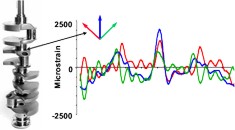
Multiaxial
 Multiaxial states of stress are very common in structures and components.
We suggest that you review the constant amplitude section first if you are unfamiliar with the basic fatigue analysis methods and terminology.
Fatigue is usually a surface phenomina so that the state of stress is biaxial because the stress normal to a free surface is zero.
Biaxial loading includes states of stress where the individual components of stress and strain can be either in-phase or out-of-phase,
sometimes called proportional and nonproportional loading. The multiaxial fatigue calculators are designed for evaluating these situations.
Unlike uniaxial fatigue, there is no consensus as to the best fatigue damage model. Indeed it is unlikely that a single model will be applicable for all materials and states of stress
and the multiaxial fatigue calculators will give estimates from more than one model.
Multiaxial states of stress are very common in structures and components.
We suggest that you review the constant amplitude section first if you are unfamiliar with the basic fatigue analysis methods and terminology.
Fatigue is usually a surface phenomina so that the state of stress is biaxial because the stress normal to a free surface is zero.
Biaxial loading includes states of stress where the individual components of stress and strain can be either in-phase or out-of-phase,
sometimes called proportional and nonproportional loading. The multiaxial fatigue calculators are designed for evaluating these situations.
Unlike uniaxial fatigue, there is no consensus as to the best fatigue damage model. Indeed it is unlikely that a single model will be applicable for all materials and states of stress
and the multiaxial fatigue calculators will give estimates from more than one model.
Fatigue Calculators
Fatigue Analyzers
Sign in or sign up to use these analyzers